Philadelphia is the largest city in Pennsylvania and the
fifth-most-populous city in the United States.
 It is
located along the Delaware and Schuylkill rivers. The city has a
population of 1.5 million. Philadelphia is the economic and
cultural center of the Delaware Valley, home to 6 million people
and the country's fifth-largest metropolitan area.
It is
located along the Delaware and Schuylkill rivers. The city has a
population of 1.5 million. Philadelphia is the economic and
cultural center of the Delaware Valley, home to 6 million people
and the country's fifth-largest metropolitan area.
In 1682, William Penn founded the city to serve as capital of
Pennsylvania Colony. By the 1750s it was the largest city and
busiest port in British America. During the American Revolution,
Philadelphia played an instrumental role as a meeting place for
the Founding Fathers of the United States, who signed the
Declaration of Independence in 1776 and the Constitution in 1787.
Philadelphia was one of the nation's capitals during the
Revolutionary War, and the city served as the temporary U.S.
capital while Washington, D.C., was under construction. During the
19th century, Philadelphia became a major industrial center and
railroad hub.
Philadelphia has shifted to an information- and service-based
economy. Financial activities account for the largest sector of
the metro economy, and it is one of the largest health education
and research centers in the United States. Philadelphia’s history
attracts many tourists. Philadelphia is known for its arts and
culture. The cheesesteak and soft pretzel are emblematic of
Philadelphia cuisine, which is shaped by the city’s ethnic makeup.
The city has more outdoor sculptures and murals than any other
American city, and Philadelphia’s Fairmount Park is the largest
landscaped urban park in the world.
Rittenhouse Square
The conference hotel is located near Rittenhouse Square, which is on the National Register of Historic Places and was included as one of the five parks in William Penn’s 1683 plan for the city. Originally known as Southwest Square, in 1825 it was renamed in honor of noted Philadelphian David Rittenhouse who served as treasurer to the Continental Congress during the Revolutionary War. The square is a popular gathering place bustling with activity. Surrounded by charming shops, restaurants, and boutiques, it is conveniently located near many of Philadelphia’s “must-see” places. It is a 20 minute walk to the new Barnes Foundation Museum, Franklin Institute Science Museum, the Museum of Natural History, the Rodin Museum, the Philadelphia Art Museum, and many others.
Walking Tours

Reading Terminal Market
Located about 12 blocks from the Radisson, right behind the Philadelphia Downtown Marriott (1201 Market Street),
is the Reading
Terminal Market. It occupies the
ground floor and basement of the renovated Reading train shed.
There are entrances to the market on Filbert Street, 12th Street,
and inside the convention center. With over a hundred shops, the
market boasts vendors selling meats, fish, groceries, ice cream,
flowers, baked goods, crafts, books, clothing, and
specialty/ethnic foods. Any visit to the market must include a
stop at Bassett’s Ice
Cream, a Philadelphia landmark since 1861, conveniently
located on the 12th and Filbert Streets intersection next to the
hotel.
Chestnut Street Shopping
Two blocks south of the Reading Terminal Market you will find the upscale shops
along Chestnut Street. The walk down Chestnut Street has shops
such as J. Crew, Nine West, Express, Godiva Chocolates, Sephora
& Daffy’s, H&M, and many more stylish shops. The Shops at Liberty Place
is just down the block from Continental.
Once you’ve exhausted the Chestnut Street possibilities, cut down
to the intersection of Walnut Street and Broad Street where you
will find Shops at
the Bellevue. The historic Bellevue building anchors Rittenhouse Row and
the Avenue of the Arts
where designer shops such as Nicole Miller, Polo/Ralph Lauren, and
Williams-Sonoma are located. Teuscher Chocolates
is also in this area allowing you to complete your chocolate
cravings for this walking tour. This walking tour is a great place
to find coffee shops with local flavor and Italian ice cream,
Philadelphia style (13th and Sansom Streets), as well as many
locally owned/operated bookstores and local-interest stores.
Chinatown
Just beyond Reading Terminal Market starting at 11th and Arch
Streets is Philadelphia’s Chinatown.
Not as large as San Francisco’s or New York’s, Philadelphia’s
Chinatown is still a source of local pride and very robust with
friendly and helpful merchants. The entrance to Chinatown is
marked by a large archway at 11th and Arch Streets. Easy access to
its many shops and attractions can be obtained through the
entrance to Philadelphia’s Convention Center.

South Street
If you want to explore the other side of the tracks (literally) and see Philadelphia’s more funky and colorful side, head to
South Street for a famous Philadelphia cheesesteak at Jim’s Steaks.
South Street is Philadelphia’s “capitol of cool”. With a vibrant night life, South Street is on the cutting edge of fashion, music, and dining.
Historic Colonial Philadelphia

There are many recommended free
walking tours in the historic colonial section of Philadelphia. A
few recommendations include:
- Free
Tours By Foot - Guided walks through some of the
historical blocks around Independence Mall and other parts of the city.
- The
Constitutional - Download the Constitutional Walking Tour
map at this site for a walking tour adventure on your own.
- Not-So-Much Walking Tour - For those of you who would
like to take in the walking sites without so much walking,
Hop on/Hop off bus tours are
available for a quick riding tour around some of the more
notable Philadelphia landmarks. Tickets average about $25 for
adults and $10 for children.
- Horse Drawn Carriage Tours - For those seeking a slower
ride through historic Philadelphia and a little more local
flavor, not to mention local aroma, horse-drawn carriage rides
are available around Independence National Historic Park. A 20
minute private carriage ride is just under $30, enhanced by
well-trained carriage drivers entertaining passengers with
historical tales, cultural highlights, and stories of the city’s
past.
Colonial Historic Philadelphia
Independence National Historic Park
The
Independence National
Historic Park (INHP) is at the heart of the historic colonial
district in Philadelphia and a good place to start any visit to the
local Philadelphia historical sites. The Visitor Center is located
at Market Street between 6th and 7th Streets, one block from
Independence Hall (Chestnut Street). The block in between the
Visitor Center and Independence Hall is the Liberty Bell Center.
The Liberty Bell Center
Visitors to The
Liberty Bell Center do not need tickets or reservations to
see the Liberty Bell. Normal hours are 9:00am to 5:00am daily.
Entrance to the Liberty Bell Center is on 6th Street between
Market and Chestnut Streets.
Independence Hall
Between March 1st and December 31st tickets are required to enter
Independence
Hall. Tickets are free, but are limited, and can be obtained
for any available time at the Visitor Center on the day of the
visit. The first tour starts at 9:00am. During the busy season
tickets are often gone by 1:00pm. The ticket window opens at
8:30am. You should arrive early (before 10:30am) to have the
greatest choice of times. You may also reserve tickets in
advance for a small fee.
There are many historical sites around INHP that may be of
interest to visitors. Many of Philadelphia’s historical sites are
easily seen by walking through the area on one’s own. (Guided
tours are also available through local touring companies. Most
tours cost between $15 and $20 per person.) A few sites that are
within a 10 minute walk from INHP include the following:
Elfreth’s Alley & Mantua Maker’s Museum House
Elfreth’s Alley
is named after Jeremiah Elfreth, a blacksmith and land speculator,
who built many of the alley’s homes in the mid-18th century. The
homes were often rented to artisans such as cabinetmakers,
silversmiths, pewterers, glass blowers, and wagon builders.
Dwellings in the “center of the city” were owned by prosperous
merchants leaving the artisan middle class to congregate on the
“outskirts” of the city along Elfreth’s Alley which is now
considered the nation’s oldest residential street. Try not to miss
Bladen’s Court located midway down the street; this “alley within
an alley” leads to a charming circular courtyard. Mantua Maker’s
Museum is located at house #126. Tickets to the museum can be
purchased at house #124.
Betsy Ross House
Located at 239 Arch Street between 2nd and 3rd Streets, the Betsy
Ross House is an easy walk from INHP. Admission is
$5 for adults and $4 for children.
Franklin Court
Located 2 blocks east of INHP,
Franklin
Court is the site of Benjamin Franklin’s house. The original
house no longer exists; it was razed in 1812. In its place is a
54-foot high steel skeleton “Ghost Structure” in the shape of the
original house. The site also contains the US Postal Service
Museum, the Franklin Print Shop, and the Franklin Museum which
contains many of the original plans for the house as well as other
Franklin documents. It is not uncommon to run into one of the many
“official” Franklin impersonators in this area.
The Todd House
 One block east of Independence Hall is the John Todd
House. John Todd was a Philadelphia lawyer who succumbed to
yellow fever in 1793. The house’s historical significance is due
to John Todd’s wife, Dolley. Known as a “fabulous and spirited”
hostess, Mrs. Todd’s hostess skills came in handy when her second
husband, James Madison, became the fourth president of the United
States. Her strength and skill also served her well when she and
President Madison evacuated the White House in 1812.
One block east of Independence Hall is the John Todd
House. John Todd was a Philadelphia lawyer who succumbed to
yellow fever in 1793. The house’s historical significance is due
to John Todd’s wife, Dolley. Known as a “fabulous and spirited”
hostess, Mrs. Todd’s hostess skills came in handy when her second
husband, James Madison, became the fourth president of the United
States. Her strength and skill also served her well when she and
President Madison evacuated the White House in 1812.
Bishop White House
Nearby to the Todd House is the Bishop
White House. Jacob Duche headed the Anglican Church in the
colonies in the early 1770’s. Duche supported the colonists
against the British during the rebellion. This did not sit well
with the Anglican church officials in Britain who called Duche
home and forced him to recant his views. William White ultimately
succeeded him and went on to become the first Bishop of the
Protestant Episcopal Church of Pennsylvania. He was a beloved
figure in Philadelphia for his charitable work which included
ministering to those infected with Yellow Fever in the 1790’s
while many other men of wealth fled the city.
Graff House
The Graff
House is located on the corner 7th and Market Streets one
block west and one block north of Independence. In June 1776, the
Second Continental Congress assigned Thomas Jefferson, Benjamin
Franklin, and John Adams to a committee that was asked to write a
declaration which enumerated the causes that led to the severance
of ties with Great Britain. It is now well known that the
committee assigned Thomas Jefferson the task of writing the
document himself. Finding his lodging in the heart of the city
uncomfortable, Jefferson moved to the Graff house on the
“outskirts” of town where he rented furnished rooms much more to
his liking. Jacob Graff, a well known bricklayer, had built the
house only a year before. It was in this house, now known as the
“Declaration” House, that Jefferson penned the Declaration of
Independence. The original structure was torn down in 1883, but
extensive photographs of the site enabled the National Park
Service to rebuild a faithful recreation of the original building.
The exhibit includes a recreation of the two rooms Jefferson
rented on the second floor.
Historic Churches, Parks and Cemeteries
There are many more historical sites in this section of
Philadelphia. Some of the more interesting historic sites are
churches and cemeteries that date back to colonial times. The
cemeteries are the final resting place for many of the historical
colonial figures important to Pennsylvania history and the early
history of the nation. Tours of churches and cemeteries can be
arranged through local organizations. Directly behind Independence
Hall are Independence Square and Washington
Square which date back to original plans for the city laid
out by the City’s founder, William Penn. Park benches and walkways
make these squares a very pleasant and peaceful rest while taking
in the sites.
Other Philadelphia Landmarks and Sites
Post-Colonial Historic Philadelphia
Philadelphia has been at the center of many other historical
events since the Colonial and Revolutionary periods. The city
played a major role in the Underground Railroad prior to the Civil
War. The Johnson House and the William Still Residence are just
two examples of Underground Railroad stops that are now a part of
the historical register. For those of you planning a little extra
time in Philadelphia or a family vacation, here is a list of some
other recommended historical landmarks to visit. Click on the link
for more information.
The Arts and Sciences in Philadelphia
Philadelphia has a very active and diverse art and performance
scene. There are many interesting museums, theaters, performance
venues, and attractions that would be of interest to families on
vacation. A few regional suggestions are mentioned here. These are
all within the city or an easy day-trip from the city. Click on
the link for more information.

A Few Other Interesting Suggestions

Parking:
Information about parking is available on the
hotel services webpage.
Last modified August 5, 2014.

